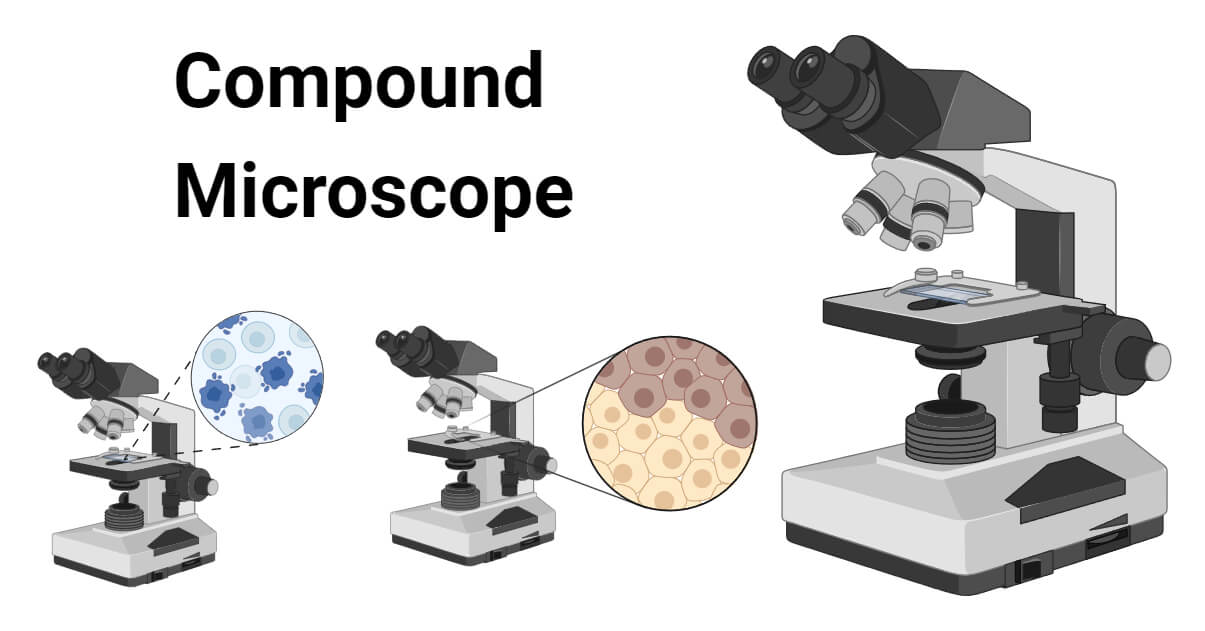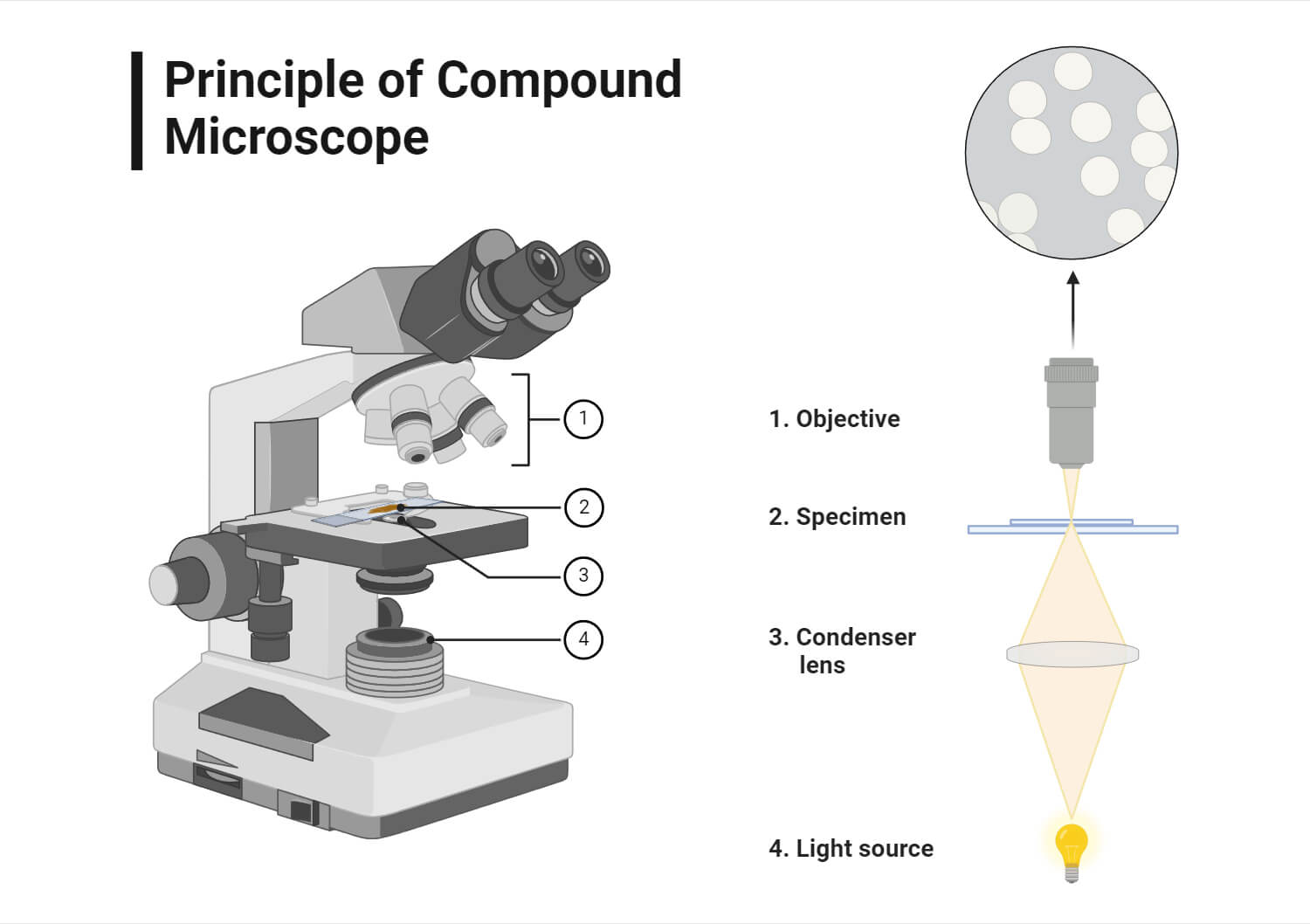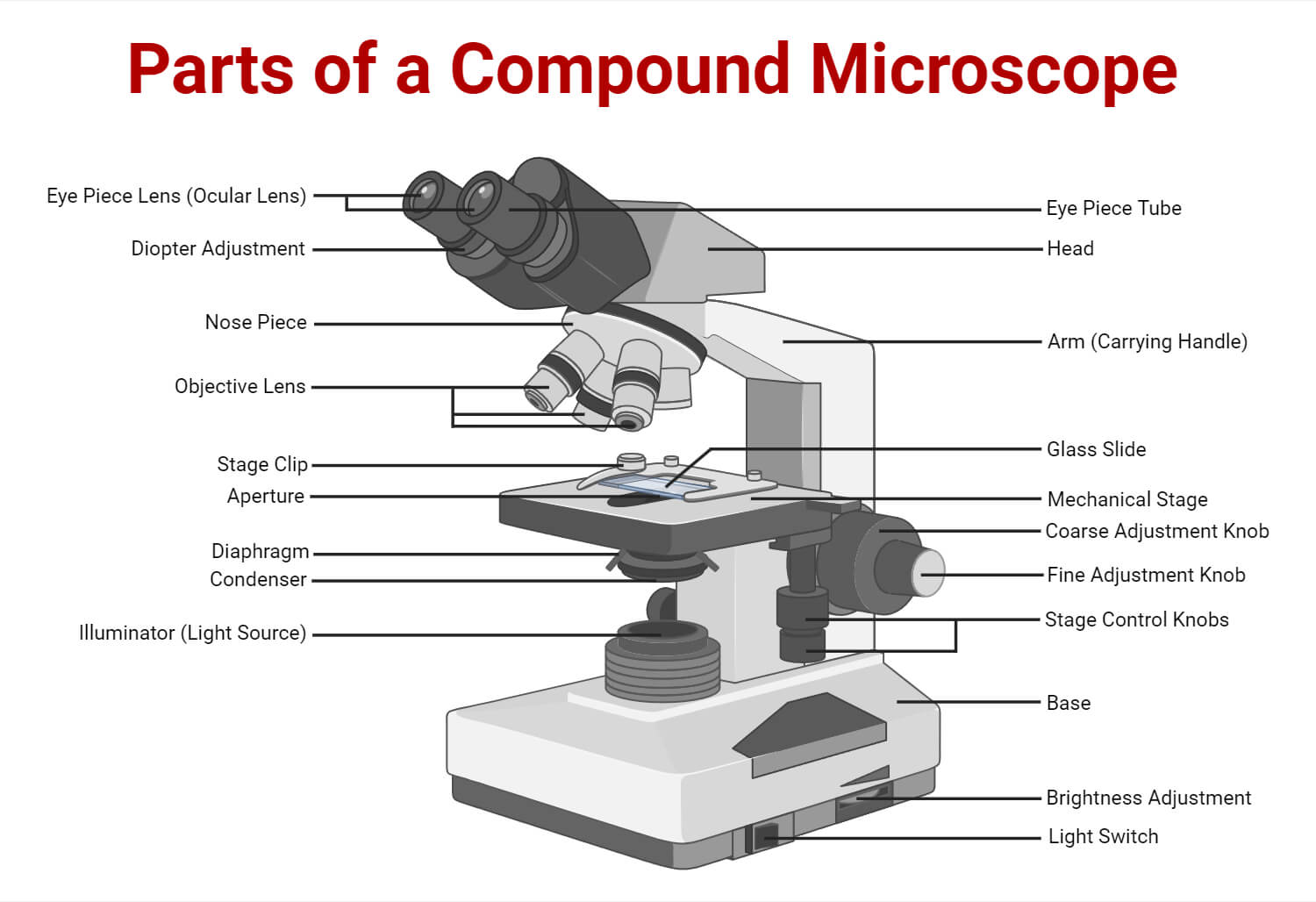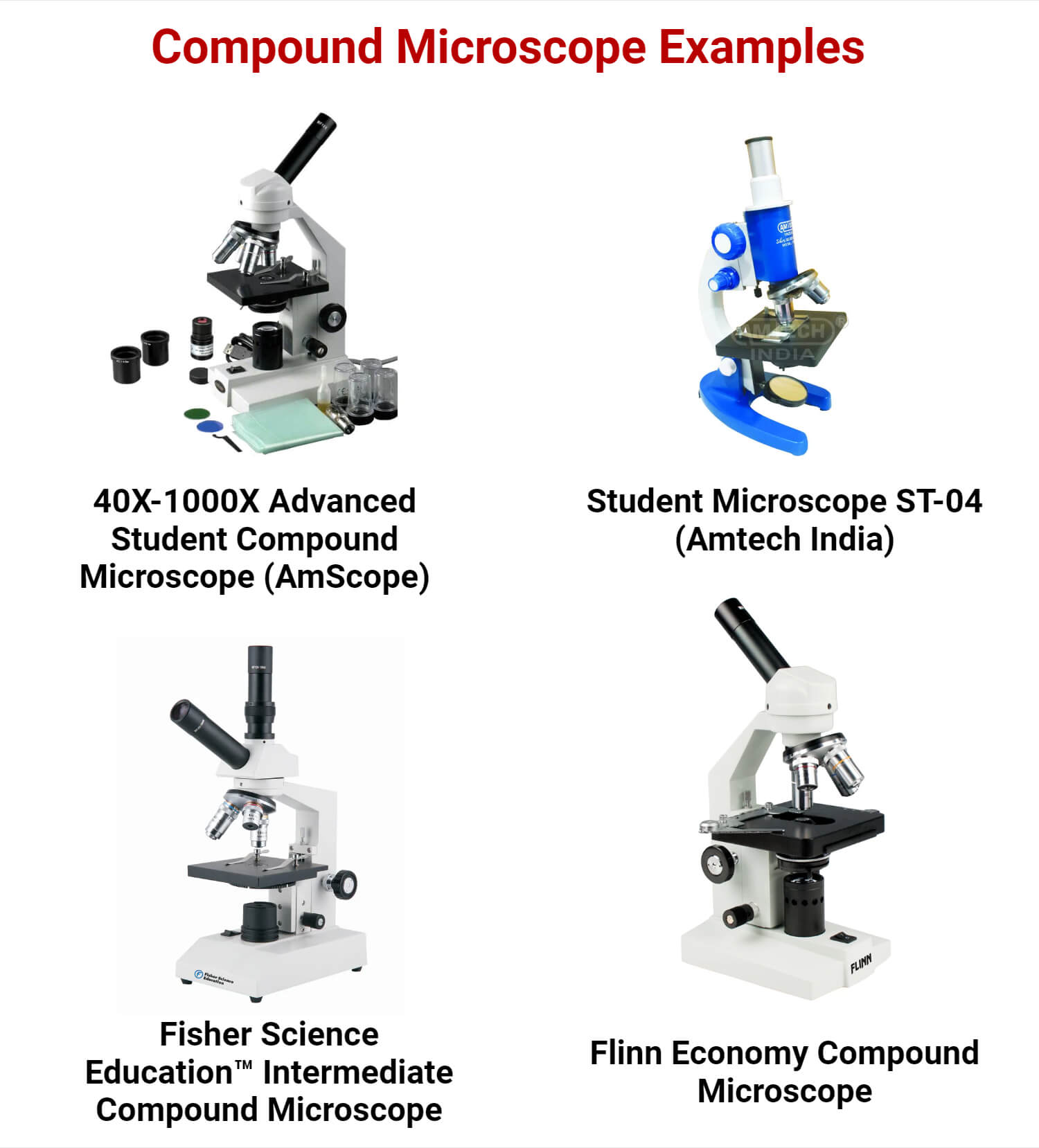Compound microscopes are built using a compound lens system where the primary magnification is provided by the objective lens, which is then compounded (multiplied) by the ocular lens (eyepiece).
The objective lens is the lower lens nearest to the specimen which enlarges the specimen and is also referred to as the primary lens while the eyepiece is the top ocular lens that lies nearest to the viewer’s eye and also known as secondary lens. They offer two-dimensional visual information.

Magnifications for the various objectives on compound microscopes typically range from 4x to 100x. Commonly used eyepieces are 10x, giving in total magnifications of 40x to 1000x.
The compound microscope is widely thought to have been created by Zacharias Janssen, using collapsing tubes that produced magnifications up to 9X. However, the majority of experts believe that his father, Hans, must have had a significant hand in the construction of the instrument.
Interesting Science Videos
Principle of a Compound Microscope
Commonly, the specimen or object to be examined is mounted on a transparent glass slide and positioned on the specimen stage between the condenser and objective lenses. A beam of visible light from the base is focused on the specimen by a condenser lens. The light emitted by the specimen is captured by the objective lens, which magnifies it inside the body tube to create the primary image. This image is once more magnified by the ocular lens or eyepiece. If a higher magnification is required, the compound microscope’s nosepiece is rotated after low power focusing in order to align the higher magnification objective with the lighted portion of the slide.

Magnification of Compound Microscope
The magnifying power of the compound microscope is calculated as:
M= mo*me
where,
M= magnification power of the compound microscope
mo= magnification power of the objective lens
me= magnification power of the eyepiece
For instance, when the objective lens can magnify by 40 folds and the ocular by 10 times, the specimen will be overall magnified by 400X.
When the final image is formed at infinity, it is given as:
M = D/ fo * L/fe
where,
D= Least distance of distinct vision = 25cm
L= length of the microscope tube
fo =focal length of objective lens
fe = focal length of eyepiece
Thus, it is clearly evident that the increase in focal length of both eyepiece and objective result in a decrease of magnification power of the microscope.
Parts of a Compound Microscope
The structural and optical components of the compound microscope are as follows:
Head/ Body Tube: It forms the top section of the microscope which holds prisms and eyepiece tubes. The presence of a single head which has only one eyepiece is known as monocular head while the double head bears two eyepieces.
Arm: It is a strong and curved curvature used to hold the microscope while moving them from one place to another and also functions to connect the tube with the base of the microscope.
Base/ Foot: The term in itself defines it to be the bottom component of a microscope that acts as a prop to support the entire weight of the microscope. This facilitates placing it on a table or bench.
Nose piece: It is also known as the revolving turret which houses three to five objective lenses and is located below the head of the microscope. It can rotate in either direction to lock the objective lens over the stage aperture.
Stage: It is a platform where sample specimens are usually mounted onto a glass slide for observation/ This comes in a variety of shapes including rectangular, square or circular design. The most compound microscopes include an adjustable mechanical stage height.
Inclination joint: This facilitates tilting the microscope back for more comfortable viewing. It is a region where a pin can be found at the point where the microscope arm attaches to the base of it.
Stage Clips: Stages are equipped with two clips in its upper face in order to hold the specimen slide in place
Mechanical Stage Knob: These knobs are two in number where the former moves the slide from side to side while the later helps in back and forth movement.
Iris diaphragm: It lies immediately underneath the stage which controls the contrast by adjusting the amount of light that enters the condenser.
Condenser: It is situated beneath the iris diaphragm. It functions to converge the light coming from the light source and focus it onto the specimen
Coarse adjustment knob: A large knob with a smaller knob in the middle can be found on each side of the microscope, close to the base. This large knob raises or lowers the stage and is used to concentrate an object closely. The coarse-adjustment knob should only be utilized with low-power or scanning objective lenses.
Fine adjustment knob: These are small knobs on each side of the microscope which is used to focus an object precisely. Only the fine-adjustment knob should be used for all focusing when using the high-power objective (40X) lens.
Eyepiece/ Ocular lens: It is the lens housed at the top of the body tube through which one can observe the magnified image of the specimen on the slide. The ocular lens has a 10X magnification power.
Diopter adjustment: It helps to adjust the focus on one eyepiece while using two eyepiece lenses to gaze through a microscope to account for the disparity in vision between two eyes.
Objective Lenses: Commonly three to four objective lenses with magnification powers of 4X,10X, 40X and 100X are available in compound microscopes.
Scanning objective lens(4X): The smallest magnification offered by any objective lens is that of a scanning objective lens. A typical magnification for scanning objectives is 4x. These roughly provide viewers with enough magnification for a good overview of the slide.
Low power objective lens(10X): One of the best lenses for viewing and examining glass slide samples is the low power objective lens since it has a higher magnification power than the scanning objective lens.
High power objective lens(40X): This will be the longest objective lens if the microscope has three objectives only. It is employed to see an object in much more detail. The 40X high-power objective lens magnifies objects 40 times.
Oil immersion objective lens(100X): These are present in microscopes with four objectives which have 100X magnifying power. This requires the addition of a drop of immersion oil on the sample.
Illuminator: The condenser is illuminated by an integrated halogen lamp, usually located on the base and features a dial for adjusting the brightness on one side. However, earlier microscopes featured the mirror which acted as an illuminator by reflecting the natural light into the base of the microscope.

Operating Procedure of Compound Microscope
The following points are the steps for operating microscope:
- The lowest power objective lens (for example, 4x) should be snapped into place by rotating the revolving turret/nosepiece.
- Place the microscope slide on the stage and secure it using the stage clips.
- Turn the focus knob to raise the stage as you look at the objective lens and stage from the side. Without letting the objective hit the coverslip, raise it as high as it will go.
- Adjust the focus knob to focus the image while looking through the eyepiece.
- Adjust the light’s brightness and the condenser’s position for the high amount of light.
- When the sample is in the center of the field of vision, move the microscope slide.
- For the clearest image, adjust the condenser and light intensity after focusing the sample using the focus knob.
- You can switch to the next objective lenses once you obtain a clear image of your sample with the lowest power objective. The sample’s focus and/or the condenser and light intensity may need to be adjusted.
- Make sure the objective lens doesn’t touch the slide!
- After you’re done, lower the stage, click the low power lens into place, and then take out the slide.
Applications of Compound Microscope
- A compound microscope is very helpful in pathology labs while conducting blood analysis for disease diagnosis.
- It aids in the visualization and understanding of the microbiological realm of bacteria and viruses.
- Compound microscopes can be used to determine if minerals are present or absent in addition to the presence of metals.
- The usage of a microscope in academic experiments is advantageous for students in schools and universities which facilitate them to see bacteria and viruses, that are normally undetectable to the naked eye,
- In forensic laboratories, human cells are taken and studied under a microscope to help identify and solve various crimes.
- A compound microscope is used to inspect plant cells and identify the microorganisms living within.
Advantages of Compound Microscope
- It is fairly simple to use and handle a compound light microscope.
- It is simple to store because of its modest size.
- It is a crucial instrument in the fields of biology and medicine.
- It enables us to see real-time specimen samples.
- Compared to an electron microscope, it is more affordable.
Limitations of Compound Microscope
- The highest magnification achievable with a compound light microscope is 2000x.
- It cannot be used to observe some specimens, including some viruses, atoms, and molecules.
Precautions while using Compound Microscope
- Never put your fingers near the glass portion of the lenses. If you want to clean your lenses, only use special lens paper.
- When not in use, turn off the light source for the microscope. As a result, lamps will last longer and use less energy.
- Using both hands when holding a microscope is recommended. Take hold of the arm with one hand and support it with the other hand by placing it beneath the base.
- Always use a coverslip while doing temporary (wet mount) preparations.
- Remove the slide from the stage and rotate the lowest power objective lens into place before putting the microscope away.
Examples of Compound Microscope
40X-1000X Advanced Student and Professional Compound Microscope (AmScope)
- Use of color-coded objective lenses and 10X eyepieces for four different settings, a 40X to 1000X magnification range is possible.
- Siedentopf binocular head that can be adjusted for any user’s preferences with a comfortable 30° incline, 360° rotation, and interpupillary and dioptric adjustments.
- An innovative new ergonomic design that has a taller frame and an enhanced base aids to lessen fatigue during prolonged use.
Student Microscope ST-04 (Amtech India)
- Body: Sturdy weighty body with horseshoe-shaped movable base that can be inclined up to 90 degrees and has a safety stopper for slides.
- Tube: 160mm in length, triple rotating nosepieces with a stopclick.
- Stage: A fixed 110 x 110 mm stage with stage clips to hold the specimen in place.

Fisher Science Education™ Intermediate Compound Microscopes: Dual View (Fisher Science Education™ 128CLED)
- The objectives for DIN 4X, 10X, and 40XR are achromatic, parfocal, par-centred, and color-coded.
- The 3-hole nosepiece includes positive click stops and is ball-bearing mounted for more exact alignment.
- Viewing head rotates 360 degrees for simple eyepiece repositioning and sharing by many students.
- Dual-view Optical System with tubes that are 30° inclined and vertical.
Flinn Economy Compound Microscope (Flinn Scientific)
- The battery life is increased by the energy-efficient LED illumination for continuous all-day use.
- To avoid loss and harm, the achromatic eyepiece is secured in place. Sharp viewing of a variety of specimens is guaranteed with achromatic DIN objective lenses.
- Stage clips, an iris diaphragm with a single lens condenser, a triple nosepiece housing three objective lenses, and other features are included.
References
- https://byjus.com/biology/study-of-the-parts-of-a-compound-microscope/
- https://microscopeinternational.com/compound-microscope-parts/
- https://learning.hccs.edu/faculty/m.bracamonte/biol-2401/AP%201%20Course%20Material/ap-1-lab-handouts/microscope-1/parts-of-the-compound-microscope
- https://www.microscope.com/compound-microscope-parts
- https://accu-scope.com/news/what-are-the-different-magnifications-of-objective-lenses/
- https://labproinc.com/blogs/microscopes-lighting-and-optical-inspection/the-ultimate-guide-to-choosing-a-compound-light-microscope-pros-cons-and-limitations
- https://www2.mrc-lmb.cam.ac.uk/microscopes4schools/microscopes2.php
- https://laboratoryinfo.com/compound-microscope/
- https://www.cambridge.org/core/journals/microscopy-today/article/pioneers-in-optics-zacharias-janssen-and-johannes-kepler/71354DB92C368F7E368CB06BD35501A7
- https://sciencestruck.com/compound-microscope-basics-uses
- https://amscope.com/collections/compound-microscopes/products/c-b270
- https://amtechindia.in/product/student-microscopes-manufacturers-ambala-india/
- https://www.fishersci.com/shop/products/fisher-science-education-intermediate-compound-microscopes-dual-view/S71001E
- https://www.flinnsci.com/flinn-economy-compound-microscope-4x-10x-40x-100x-mechanical-stage/ms1122/
- https://www.microscopeworld.com/t-glossary.aspx

It was helpful.
It’s really very useful🤩🤩
Thank you for your nice notes on this platform
I really love this App
THANK YOU FOR GOOD BOOKS
Thanks sir for your support
Please give us pdf versions of the notes
You can copy paste from the website. I have not made PDF version of these notes. Thanks.